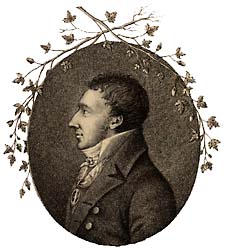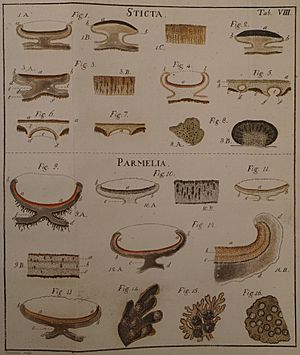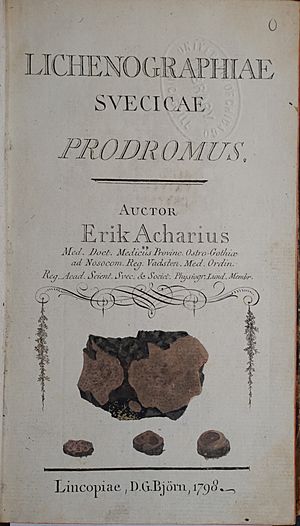Erik Acharius facts for kids
Quick facts for kids
Erik Acharius
|
|
|---|---|
 |
|
| Born | 10 October 1757 |
| Died | 14 August 1819 (aged 61) |
| Citizenship | Sweden |
| Alma mater | Uppsala University |
| Known for | Pioneering lichenology |
| Awards | Member of the Linnean Society |
| Scientific career | |
| Fields | Botany Lichenology |
| Academic advisors | Carl Linnaeus |
| Author abbrev. (botany) | Ach. |
Erik Acharius (born October 10, 1757 – died August 14, 1819) was a Swedish botanist. He is famous for being the "father of lichenology". This means he was the first to properly organize and name different types of lichens. Acharius was also the very last student of the well-known scientist Carl Linnaeus.
Contents
Erik Acharius's Early Life and Education
Erik Acharius was born in 1757 in a town called Gävle, Sweden. He was taught at home until he went to high school in 1770. In 1773, he started studying at Uppsala University. There, he learned about nature and medicine from Carl Linnaeus. Acharius was the last student to complete a research paper under Linnaeus.
His paper was about a plant from Southern Africa. Linnaeus had mistakenly thought it was a fungus. Because of this, Acharius is known as Linnaeus's last student. After finishing his studies at Uppsala in 1776, Acharius worked for the Royal Swedish Academy of Sciences in Stockholm. He also finished his medical training at Lund University in 1782.
Career and Family Life
In 1785, Acharius became a medical officer in Vadstena. He later became a district medical officer in 1789. He even started a new hospital in Vadstena in 1795 and became its director. In 1803, he was given the title of professor. Acharius was also a talented artist. He drew pictures for other scientists' books about plants and lichens.
Erik Acharius married Helena Dorotea Scholander in 1787. After she passed away, he married Margareta Maria Hoffberg in 1804. He had four children. Acharius lived the rest of his life in Vadstena. He passed away in 1819 at age 61 while looking at a collection of lichens in his garden.
Discovering Lichens: Acharius's Main Work
Acharius was part of a group of Swedish botanists who continued Linnaeus's work. Linnaeus wanted to classify, or organize, all living things. Acharius focused on lichens. Before him, all lichens were grouped together as one type. Acharius changed this completely.
During his life, he identified and named over 3,300 different kinds of lichens. He put them into 40 different groups. This was a huge step forward in understanding lichens.
Important Books on Lichens
Acharius published his first book, Lichenographiae Suecia prodromus, in 1798. This book described all the lichens known in Sweden. It was the first book to use a two-part naming system (like Homo sapiens for humans) for lichens. It also expanded their classification beyond just one group.
Acharius exchanged many letters with another scientist, Olof Swartz. Swartz helped Acharius develop his system for classifying lichens. Swartz also introduced Acharius to other important scientists around the world. This helped Acharius share his new discoveries about lichens with many people.
After his first book, Acharius sent a copy to James Edward Smith, who led the Linnean Society in London. Smith was so impressed that he made Acharius a member. Acharius then published more important books:
- Methodus qua omnes detectos Lichenes (1803)
- Lichenographia universalis (1810)
- Synopsis methodica lichenum (1814)
He sent copies of these books, along with hundreds of lichen samples, to the Linnean Society. Over his lifetime, Acharius collected more than 5,500 lichen samples. Most of these are now kept at the Botanical Museum of the Finnish Museum of Natural History.
New Words for Lichens
Acharius also created many new words that scientists still use today to describe lichens. For example, he named the pits on the underside of Sticta lichens as cyphellae in 1794. He also added terms like apothecium, cephalodium, podetium, proper margin, soredium, and thallus in 1803. Later, he added thalline margin in 1810 and mazaedium in 1817.
Acharius's Lasting Impact
Acharius's work inspired many new lichen scientists across Europe. Two German scientists, Friedrich Weber and Daniel Matthias Heinrich Mohr, wrote a book in 1804 that featured his work on lichens. It even included four illustrations by Acharius.
William Borrer, who is called the "father of British lichenology," was greatly influenced by Acharius's samples and books. Borrer studied these in 1809, and they became the foundation for his own research. Another person, Thomas Gage, published a book in 1815 with illustrations of every type of Cenomyce lichen that Acharius had described.
Even today, some of Acharius's original ways of classifying lichens are still used. The International Association for Lichenology has a special award for lifetime achievement in lichenology named the Acharius Medal in his honor. In 1992, a special plaque was placed on the house in Vadstena where he lived for many years.
Awards and Recognitions
Erik Acharius was a member of several important scientific groups:
- The Royal Physiographic Society in Lund (1795)
- The Royal Swedish Academy of Sciences (1796)
- The Linnean Society of London (1801)
- The Royal Society of Sciences in Uppsala (1810)
He was also made a Knight of the Order of Vasa in 1809.
Many things have been named after Acharius to honor his contributions:
- The plant group Acharia (named in 1794)
- Several plant species, like Rosa acharii and Conferva acharii
- An insect called Tortrix achariana
- The Acharius Medal, awarded for achievements in lichenology
Acharius's collections of lichens are now kept in several museums. These include the Finnish Museum of Natural History in Helsinki, the Botanical Museum in Uppsala, the Swedish Museum of Natural History, and the Botanical Museum in Lund. His personal papers are in the Uppsala University Library. Some of his collected samples are also at the Natural History Museum, London.
Acharius's Main Publications
Here are some of Erik Acharius's most important books:
- Lichenographiae svecicae Prodromus (Beginning of a Lichenography of Sweden) 1798
- Methodus qua omnes detectos Lichenes (A Method by which Everyone Can Identify Lichens) 1803
- Lichenographia universalis (A Universal Lichenography) 1810
- Synopsis methodica Lichenum (Taxonomical Arrangement of Lichens) 1814
See also
 In Spanish: Erik Acharius para niños
In Spanish: Erik Acharius para niños
- List of mycologists




